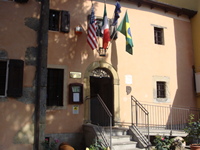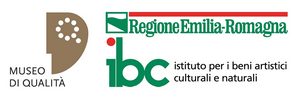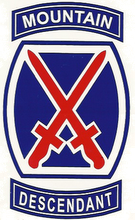Museal system

The MUSEAL SYSTEM of Iola Montese was founded in 2011 and consists of a series of collections, of approximately 4,000 objects, which are exhibited over 16 rooms with a total area of about 600 sqm. Additionally, there are itineraries through the battlefields where Allied and German soldiers fought during the months between late 1944 and early 1945 on the last line of defence of the Green Line better know as the Gothic Line.
The museum, recognized MUSEUM OF QUALITY by the Institute of Artistic Heritage Cultural and Natural Heritage of the Emilia Romagna Region, overlooking the square of the village, which is located about 920 meters above sea level, beside to the church built in 1630's. The hospitality is guaranteed by large parking area and nearby restaurants, one of which is reached by a short walk.
 The collections MEMOIRS OF ITALY are dedicated, since its establishment in 2003, to the World War II period and consist of five rooms devoted to the armies that fought in the areas adjacent the hill town of Iola between last months of 1944 until the end of war in Italy: Wehrmacht Heer, 232nd Infantry Division and the 114th Jager - U.S. 10th Mountain Division - BEF, Brasilian Expeditionary Force and the Royal Italian Army.
The collections MEMOIRS OF ITALY are dedicated, since its establishment in 2003, to the World War II period and consist of five rooms devoted to the armies that fought in the areas adjacent the hill town of Iola between last months of 1944 until the end of war in Italy: Wehrmacht Heer, 232nd Infantry Division and the 114th Jager - U.S. 10th Mountain Division - BEF, Brasilian Expeditionary Force and the Royal Italian Army.
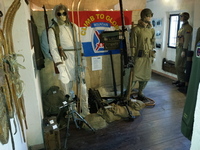 All items, collected by typology, represent what was available to soldiers on the front line. On display there are uniforms, decorations, badges, weapons, everyday objects, medical first aid and various type of clothing and accessories. The collections, which highlight the technical features and quality of the equipment available until the first line of battle, aim to understand the logistic organization behind the fighters on the various battlefields in accordance with the axiom that wars are won by the army with the men more motivated and the better logistics organization. The museum was officially recognized by the 10th Mountain Division Descendants who organizes, every three years, the return on the battlefields of the Tuscan-Emilian Apennine. The next tour is scheduled on June and will be an important event by resorting the 70th anniversary of the 5th Army battle that, in this area, led the breakthrough of the German defenses by 10th Mountain Division soldiers. The Brazilians soldiers, after the conquest of Monte Castello and Montese, replaced the Americans in the backline. In the rooms devoted to the history of our country there are also books, report cards and school objects of the prewar period.
All items, collected by typology, represent what was available to soldiers on the front line. On display there are uniforms, decorations, badges, weapons, everyday objects, medical first aid and various type of clothing and accessories. The collections, which highlight the technical features and quality of the equipment available until the first line of battle, aim to understand the logistic organization behind the fighters on the various battlefields in accordance with the axiom that wars are won by the army with the men more motivated and the better logistics organization. The museum was officially recognized by the 10th Mountain Division Descendants who organizes, every three years, the return on the battlefields of the Tuscan-Emilian Apennine. The next tour is scheduled on June and will be an important event by resorting the 70th anniversary of the 5th Army battle that, in this area, led the breakthrough of the German defenses by 10th Mountain Division soldiers. The Brazilians soldiers, after the conquest of Monte Castello and Montese, replaced the Americans in the backline. In the rooms devoted to the history of our country there are also books, report cards and school objects of the prewar period.
 The museum is surrounded by the grounds of the bloody battlefields, sites of the fighting between 1944 and 1945 involving both soldiers and the civilian population, in a winter, among the coldest in living memory. Today, crossing these battlefields, we can find PATHS OF THE GOTHIC LINE which follow the ridges and woodlands where the trenches of the opposing armies are still visible and where war relics can still be found. A moment of reflection among secular chestnut trees and memories that are fading with the passing of time.
The museum is surrounded by the grounds of the bloody battlefields, sites of the fighting between 1944 and 1945 involving both soldiers and the civilian population, in a winter, among the coldest in living memory. Today, crossing these battlefields, we can find PATHS OF THE GOTHIC LINE which follow the ridges and woodlands where the trenches of the opposing armies are still visible and where war relics can still be found. A moment of reflection among secular chestnut trees and memories that are fading with the passing of time.
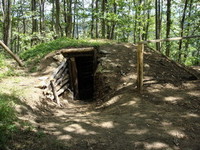
 The COLLECTION OF MONTESINE THINGS is dedicated to the rural civilization and since the costruction of the museum in 1992, is characterized by a series of collections that narrate the lives of our fathers in the second half of 1800's and the first half of 1900's. The rooms take the visitor through typical rural dwellings, the processing and produce of agricultural products and crafts that have been forgotten in time.
The COLLECTION OF MONTESINE THINGS is dedicated to the rural civilization and since the costruction of the museum in 1992, is characterized by a series of collections that narrate the lives of our fathers in the second half of 1800's and the first half of 1900's. The rooms take the visitor through typical rural dwellings, the processing and produce of agricultural products and crafts that have been forgotten in time.
 The path of a peasant home reconstructs the environment of the kitchen, where the family gathered especially in the long winter evenings, the bedroom and the activities that took place in the home such as spinning and weaving. The path of the products processing is developed from the equipment to till the earth until the various rooms dedicated to the processing of the grapes, chestnuts, potato and wheat. The faithful reconstruction of the stall completes the picture.
The path of a peasant home reconstructs the environment of the kitchen, where the family gathered especially in the long winter evenings, the bedroom and the activities that took place in the home such as spinning and weaving. The path of the products processing is developed from the equipment to till the earth until the various rooms dedicated to the processing of the grapes, chestnuts, potato and wheat. The faithful reconstruction of the stall completes the picture.





